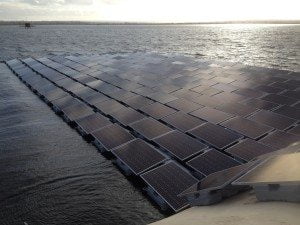

Energy
Europe’s Biggest Floating Solar Panel Project Charges Ahead in London
Europe’s biggest ever floating solar panel array is being installed on London’s Queen Elizabeth II reservoir as part of Thames Water’s ambitious bid to self-generate a third of its own energy by 2020. Just over 23,000 solar photovoltaic (PV) panels will be floated on the reservoir near Walton-on-Thames, utilising a normally redundant suburban space on the surface, following an agreement between Thames Water, Ennoviga Solar and Lightsource Renewable Energy.
The innovative floating pontoon will cover around a tenth of the reservoir – enough to fill eight Wembley football pitches.
The low carbon, renewable energy produced will be used to help power the nearby water treatment works putting downward pressure on customer bills. It will have a total installed peak capacity of 6.3 megawatts and is expected to generate 5.8 million kilowatt hours in its first year – equivalent to the annual consumption of around 1,800 homes.
Thames Water’s energy manager, Angus Berry said: “Becoming a more sustainable business is integral to our long term strategy and this innovative new project brings us one step closer to achieving our goal – this is the right thing for our customers, the right thing for our stakeholders and most importantly the right thing for the environment.”
Lightsource, Europe’s leading solar energy company, has extensive expertise in both ground and roof mounted solar installations and is managing the installation. Drawing on the experience from its in-house team of engineers, planners and project managers, the company will oversee the deployment of more than 61,000 floats and 177 anchors, which will provide the floating platform for the solar array.
Nick Boyle, CEO at Lightsource, said: “We’re delighted to have begun work on another ambitious milestone project for Lightsource with our first floating solar installation. Over the last five years we’ve successfully completed ground and roof installations of all shapes and sizes, but this project has some obvious differences and has presented our team with a set of fresh challenges to overcome.
“There is a great need from energy intensive industries to reduce their carbon footprint, as well as the amount they are spending on electricity and solar can be the perfect solution. We’re therefore constantly evolving new skill sets to ensure that all of our projects deliver maximum energy generation over the lifetime of the installation.”
Ennoviga Solar’s co-founder Stefano Gambro added: “We’re delighted to have delivered another successful solar project, also for Thames Water, generating cost-effective electricity right where it’s used. Refreshingly, Lightsource has the skills, courage and persistence to understand this innovative technology and invest in Europe’s largest floating solar project.”
Eva Pauly, International Business Development Director at Ciel et Terre International, the manufacturer of the floating mounting system, added: “This is our largest project outside of Japan and the first one with European bank financing, proving that our technology is not only suitable for water utilities, but has also been recognised as bankable in Europe as well as Asia.”
As well as setting a target of generating 33% of its own renewable energy by 2020, Thames Water is striving to become more efficient to reduce its reliance on the grid. It generated a total of 12.5% of its electricity requirements from renewable sources in 2014/2015, which is a 4% increase on the year before. In 2015, Thames Water pledged to support the objectives of the Paris Agreement to limit the global temperature rise to less than 2 degrees Celsius and this project will contribute to achieving this goal.
The Queen Elizabeth II reservoir was commissioned in 1962 and has a capacity of 23.6 Megalitres of water with a surface area of 128.3 hectares and a perimeter of 4.3km. Thames Water currently has solar panels on 41 of its sites.


 Environment10 months ago
Environment10 months agoAre Polymer Banknotes: an Eco-Friendly Trend or a Groundswell?

 Environment12 months ago
Environment12 months agoEco-Friendly Home Improvements: Top 7 Upgrades for 2025

 Features9 months ago
Features9 months agoEco-Friendly Cryptocurrencies: Sustainable Investment Choices

 Features10 months ago
Features10 months agoEco-Friendly Crypto Traders Must Find the Right Exchange



























